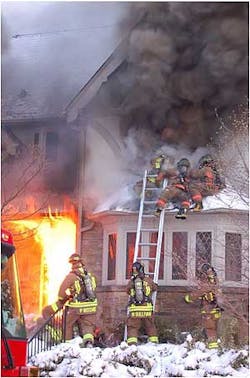When we look at various buildings and occupancies, past operational experiences; those that were successful, and those that were not, give us experiences that define and determine how we access, react and expect similar structures and occupancies to perform at a given alarm in the future. Naturalistic (or recognition-primed) decision-making forms much of this basis.
We predicate certain expectations that fire will travel in a defined (predictable) manner that fire will hold within a room and compartment for a given duration of time, that the fire load and related fire flows required will be appropriate for an expected size and severity of fire encountered within a given building, occupancy, structural system. That may be true for conventional or legacy structures, but what about modern construction and engineered structural systems? Same expectations?.......
What do you think?
There's a great series of photos depicting initial operations at a small-sized (square foot) single family residential occupancy fire that captures fire and smoke behavior, HERE and HERE
Take a moment to look back at an incident: On December 18, 1998, Three FDNY Firefighters died in-the line of duty while conducting suppression and rescue operations at fire on the tenth floor of 10-story high-rise apartment building for the elderly. This wind-driven fire event and the lessons-learned contributed directly to the current body of research and new insights on emerging strategies and tactics. NIOSH Report HERE. NIST References HERE
About the Author
Christopher J. Naum
CHRISTOPHER J. NAUM, SFPE a Firehouse® contributing editor, is a 40-year fire service veteran and a national instructor, author, lecturer and fire officer. He is an authority on building construction issues affecting the fire and emergency services and a former fire command officer, architect and fire protection engineer. Naum is a technical consultant and reviewer to the NIOSH firefighter fatality investigation and prevention program, an NFFF Firefighter Safety Advocate and formally served on the Board of Directors of the ISFSI and the IAFC Safety, Health & Survival section and faculty at the National Fire Academy. He was the 1987 ISFSI George D. Post National Fire Instructor Award recipient. Naum is the executive producer of Buildingsonfire.com and FiregroundLeadership.com, sites dedicated to building construction, adaptive fire command and firefighter safety.

